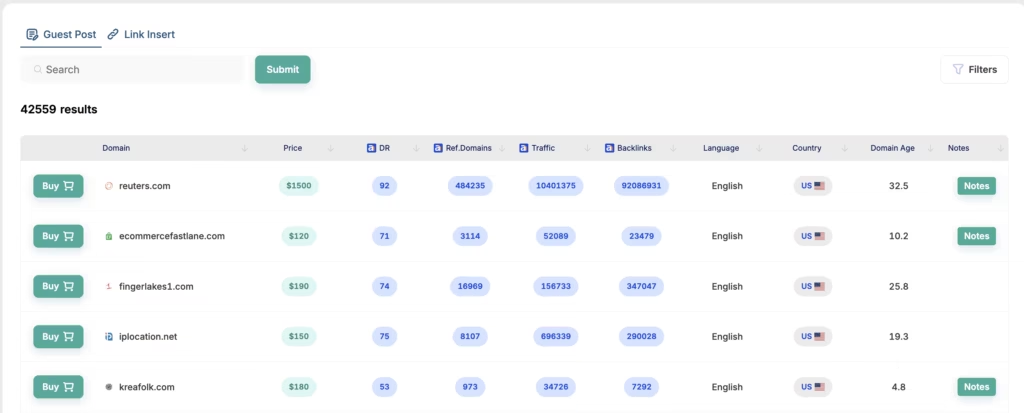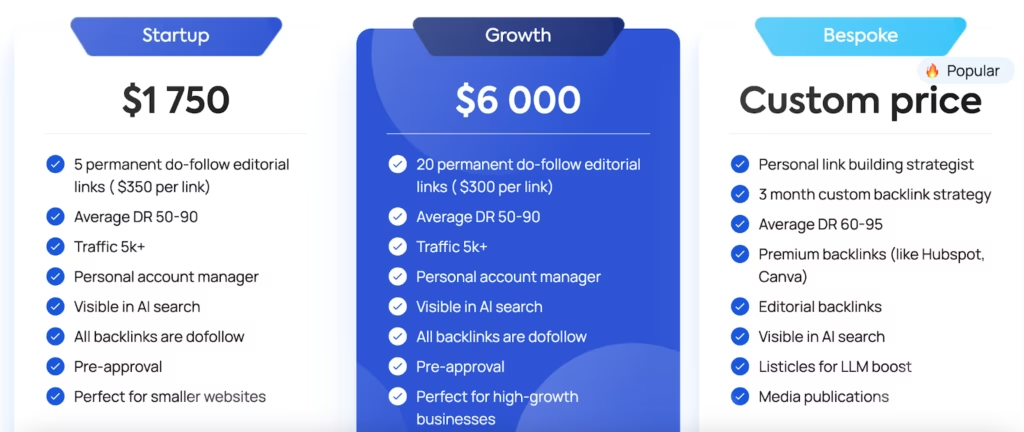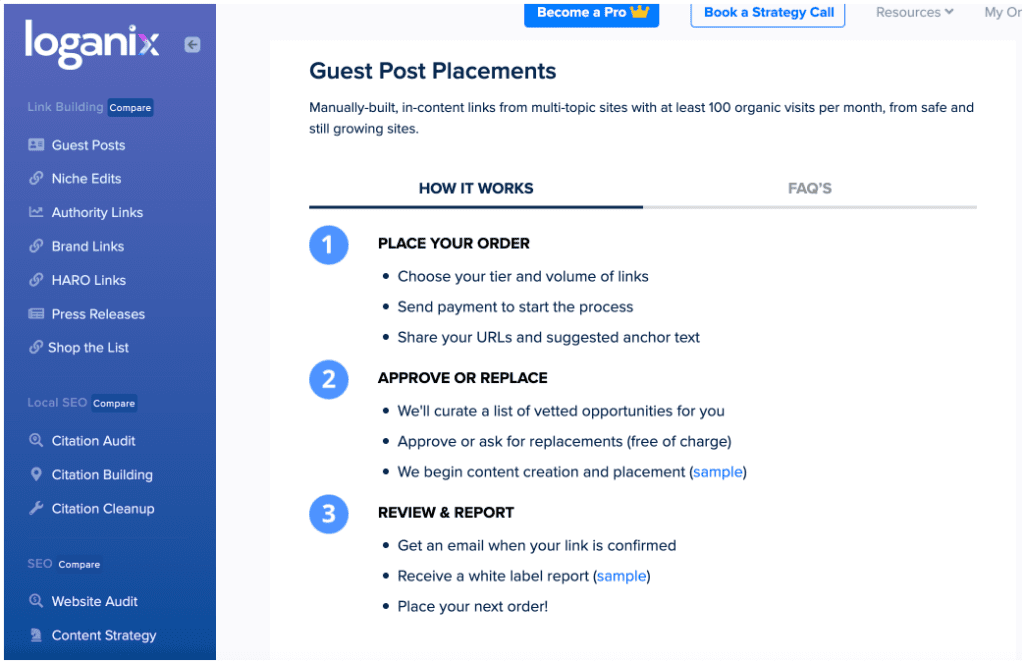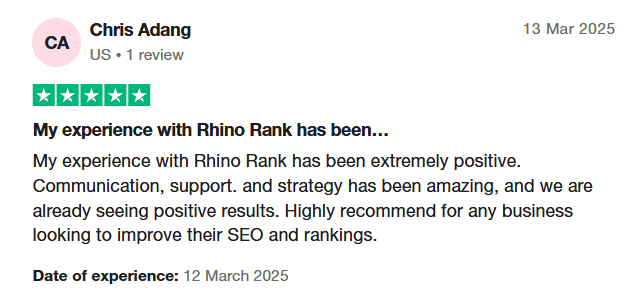Guest posting is one of the most popular link-building tactics.
Nearly 40% of SEOs who took part in our link-building survey last year named it the most effective link-building strategy.
There’s a good reason for its popularity: Writing an article for another website allows you to reach new audiences, showcase your expertise, and increase your brand visibility. All of this while maintaining control over the content and anchor texts.
But it’s also resource-intensive: you need to find relevant pages, research their content, pitch new ideas, and create the content.
Guest posting services are a less time-consuming and often cheaper alternative.
But choosing a reliable service you can trust isn’t easy.
To help you, I’ve chosen the seven best guest posting services on the market.
1. INSERT.LINK
INSERT.LINK is a link-building marketplace that offers guest posting services.

Its main strength? You have complete control over the placements.
Here’s how it works:
Once you create a free account, you get instant access to thousands of niche sites that offer guest posts, all vetted by the platform.

Search runs with filters that range from price to traffic and GEO, all kicking in as soon as you set them.
You can further filter the results by multiple metrics, including:
- Domain Rating (DR)/Domain Authority (DA)/Authority Score (AS)
- Traffic
- Price
- Language
- TLD
- Top country

All the key website metrics are visible on the results page, so you can quickly pick the websites that tick your boxes.
In the cart, you can choose to provide your own guest post or order one from INSERT.LINK. Or the website owner if they offer content creation services.
When outsourcing content creation, you can specify the article's word count. As you do it, the price gets updated. So you know exactly how much the guest post will cost.
Once you set the word count, specify your link URL and anchor text (I told you — complete control!), and confirm the order.
Currently, you can pay via PayPro Global, and Payoneer payments are coming soon.

Wondering about the turnaround times?
It’s 3-7 days (and 1-3 days for link insertions services). Which is rapid compared to other services.
What INSERT.LINK reviewers say
INSERT.LINK is a new service, so it doesn’t have many reviews yet.
However, the few reviews out there stress the quality and affordability of the backlinks, ease of use, and excellent support.

Overall, it’s a solid guest posting solution for teams on tight budgets or SEO and marketing agencies that build links for their clients at scale.
On the other hand, it isn’t a suitable service if you want a hands-off solution.
You need to have the know-how to identify relevant link placements for your website. If that’s a challenge, you’ll be better off with a fully managed service including a strategy consultation.
2. Editorial.Link
Editorial.Link is known for building real editorial backlinks and now offers a guest posting service, with a focus on listicle-style content (available only with bespoke packages).

We now offer fully managed link building packages that can include guest posts.
Here’s how it works:
You start by sending us a request.
We review your backlink profile, benchmark it against your competitors, and put together a custom proposal with the best link opportunities for your niche.
We apply strict filters when selecting potential opportunities, including:
- DR 50+
- Real organic traffic and ranking keywords
- Clean backlink profiles with no spammy history
- Niche relevance to your site
- AI search citations
- Websites that don’t openly sell backlinks
- Healthy inbound/outbound link ratio
When it comes to pricing, we offer different backlink packages. A single link starts at $375, but if you choose a package of five links, the price drops to $350 per link.
For custom campaigns, pricing is flexible and depends on your specific needs and requirements.

What Editorial.Link reviewers say:
Editorial.Link holds an impressive 5/5 average rating on Clutch, based on 75 verified reviews.
Many clients see higher rankings and more traffic driven by Editorial.Link’s approach.

All things considered, Editorial.Link is the best choice for brands and SEO agencies seeking a fully managed link building service.
3. Loganix
If you want to hand off guest posting to someone with an established reputation, Loganix may be a good choice. They’ve been in the SEO game since 2011, and they’ve worked with big names like Neil Patel and Ahrefs.

Let me walk you through how their process works:
You start by placing the order. Specify the number of links, their DR, anchor texts, and target URL. And make the payment. At this stage, you don’t see the websites for your links.
Once they process your order, Loganix gets to work. They put together a list of suitable placements for your approval. When you're happy with them, they write the content and secure the placement.
When the guest post goes live, you get an email confirmation along with a white-label report.

How much does it all cost?
Loganix has a two-tier pricing system. You can choose between:
- Regular guest posts (100+ monthly traffic, Avg DR30, 3 week turnaround) for $200.
- Premium guest posts (500+ monthly traffic, Avg DR30, 3 week turnaround) for $300.
So it isn’t cheap. You can get a DR30 for much less from other providers.

When it comes to payment, you pay with pre-purchased credits. This is convenient for teams that order multiple links a month. It also makes it easier to control your budget and track transactions.
But it also means your money is sitting in their bank account, not yours, if you don’t spend the credits right away.

What Loganix reviewers say
Loganix boasts impressive reviews on Trustpilot with an average rating of 4.8/5 (based on 92 reviews.)
Clients are generally satisfied with the link quality, quick turnaround times, and ease of use.

Overall, Loganix is a good choice for companies seeking a managed guest posting service that requires minimal supervision.
4. Adsy
Adsy is another self-serve link marketplace in the roundup and a good match if you’re looking for a guest posting service that doesn’t break the bank.

Adsy database has over 100K websites. This includes 20K+ verified publishers with feedback and ratings from previous clients.
You can filter the results by the usual metrics:
- DA/DR
- Traffic (as per Ahrefs, Similarweb)
- Country
- Language
- Niche
- Price

Speaking of prices, Adsy is one of the most affordable services. You can get a guest post on a DR80 site for as little as $27.50. And that includes the guest post creation.
The main thing to look out for is that not all the offers come from website owners but also contributors. So there’s a risk that the person may be selling links in the content they write for a publisher without their authorisation.

Another catch: The full inventory with metrics is available only to those who add funds to their account. I guess that’s their way to avoid time wasters who put strain on their resource, or worse, poach their websites by reaching out to them directly.
Ready to commit? You can top up your funds using PayPal, credit card, crypto, and even a bank transfer.

What Adsy reviewers say
Adsy has got a very 4.5/5 rating on Trustpilot. And it’s based on 162 reviews, which gives you a representative idea of what their clients think about their services.
The satisfied customers comment on the seamless publishing experience, guest post quality, and good value for money.

5. Stan Ventures
Stan Ventures is a guest posting services catering mainly to SEO and marketing agencies.

Their guest posting service is fully manual.
It involves an initial consultation, prospecting, outreach, content creation, and reporting.
Once they find suitable placements, you get a preview of the site and its metrics, proposed anchor texts, and suggested content topics for your approval.

Stan Ventures pricing is competitive. Guest post prices start from $49 for a guest post on a DA10 website and go up to $248 for a DA50 placement.
The price includes outreach, content creation (1000 words), and a 3-4 week turnaround time.

What Stan Ventures reviewers say
Stan Ventures an average Trustpilot rating 4.6/5 (56 reviews).
Clients value them for transparency, high link approval rates, and an in-depth understanding of the SEO space.

6. Rhino Rank
Rhino Rank is a UK-based link-building agency offering professional guest posting services.

Just like Stan Ventures, their 5-step process is fully-managed and manual.
They audit your website, create a 750-word guest post, identify and contact relevant publishers to secure the placement, and provide a white-label report once the link goes live.

How much does it cost?
A guest post on a DR50+ site with 1000+ monthly traffic costs $280. If you’re happy with a DR10+ link, the price goes down to 10+.

What Rhino Rank reviewers say
Rhino Rank has a 4.6/5 rating on Trustpilot based on 163 reviews.
Clients praise their account manager's professionalism, the website's inventory quality, and reliable service.

7. Fat Joe
Fat Joe is an established British outfit providing scalable link-building services to 5,000+ agencies and businesses around the world.
If you’re working with multiple clients and need guest posts at scale without the hassle of outreach and content creation, Fat Joe is a good bet.

The process is automated on your end, not theirs.
Their guest posting process is fully manual. Their team identifies the best opportunities for your website, contacts publishers, and writes the guest posts without shortcuts or black-hat tricks.

Fat Joe falls somewhere in the middle of the range. They start at $83 for a DR10+ guest post. A guest post on a DR60+ website with 1-60k traffic will set you back by $528.

Fat Joe reviews
Fat Joe has a 4.8/5 score on Trustpilot. That’s the best score in this roundup, and it’s based on 341 reviews, which speaks volumes about their client satisfaction.
Their reviewers rave about their simple ordering process, personalized link placements, and excellent communication.

Guest Posting Services FAQ
Before you leave, let’s answer a few questions about guest posting services that I often hear from my clients.
What is a guest posting service?
A guest posting service is a business that can help you write guest posts and secure placements on relevant websites.
Guest posting services include link marketplaces, where you pick the domain and create content yourself, and link-building agencies that handle the entire process from start to finish.
Is it safe to use guest post services?
Guest post services are generally safe.
Guest posting is a white-hat tactic, so the risk of incurring penalties or losing your money on links that don’t make an impact is lower.
That’s, of course, if you choose a reputable service with a proven track record in your niche.
Unfortunately, there are lots of cowboys out there offering poor-quality guest post services that ruin the industry's reputation. So do your homework before you part with your money.
How much does a guest post cost?
Prices vary from provider to provider and depend on factors like the domain authority and page traffic.
Buzzstream data shows the average cost of a guest post is $282.
You can get a guest post on a low-DR website for as little as $30, while placements on reputable high-DR industry blogs cost $800-900.
The price of a guest post normally consists of the placement and content creation fee.
Is guest posting a good link-building strategy?
Guest posting is one of the best link-building strategies at the moment.
A strategically placed guest post on an authoritative website can boost your brand visibility and bring qualified referral traffic to your website.
That’s on top of the PageRank that such a website can pass.
How do I choose the best guest posting service?
When looking for a guest posting service, consider these factors:
- Pricing: Not the most important factor, but there’s no point shortlisting services that you can’t afford.
- Niche experience: Choose a service that specializes in your niche to ensure relevant placements and quick turnaround times.
- Track record and reputation: Check client reviews, testimonials, and case studies to make sure the service can deliver.
- Guest post quality: Ask for samples of guest posts and assess the content quality, relevance, and website metrics.
- Transparent processes and reporting: Avoid services that are vague about how they secure their links and keep you in the dark about progress. Bonus points for companies that let you pre-approve the guest post placement.
- Link-replacement guarantee: You don’t want to be out of pocket when your link disappears, so look for agencies that restore or replace your links free of charge.
What’s the difference between a guest posting agency and a guest post marketplace?
A guest posting agency like Editorial.Link manages the entire process for you. Their team analyzes your site, develops a strategy, finds suitable publishers, creates the content, and places the article. You get a complete service without having to manage the details.
A guest post marketplace like INSERT.LINK is a self-service platform. You log in, browse available sites, filter by metrics such as traffic or DR, and select where you want to publish. You can upload your own article or order content directly through the platform.
Agencies are best if you want experts to handle everything. Marketplaces are better if you have SEO knowledge and prefer to choose sites and control the process yourself.
Final words
Guest posting is one of the best link-building strategies. At least, if you’re doing it yourself.
If you outsource it to a service, the quality of the posts and the results they bring may vary. So, before you commit to a guest post provider, make the effort to vet your potential partners thoroughly.
Another caveat: Relying on guest posting as a sole link building strategy isn’t a good practice. To build a natural backlink profile and immunize your website from Google algo changes, use a range of tactics. Or hire a reputable link building services that does it.
In summary, INSERT.LINK is a reliable option for guest post placements on real, high-quality sites-backed by transparent pricing and proven results.


